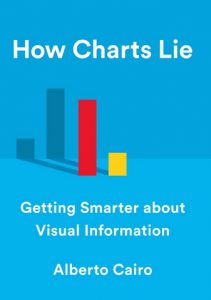Review of Deep Work by Cal Newport Megan Calvert, Educational Specialist, WDCE/AEBSCC As we shift…

How Charts Lie by Alberto Cairo (Norton, 2019)
Review by Philip Bonner, ELITE, Instructional Designer
Alberto Cairo, a data visualization expert at the University of Miami, explores how charts can deceive, both intentionally and unintentionally, in in his 2019 release How Charts Lie. Today, graphic representations of information are more common than ever, yet many consumers of this information remain unskilled in reading charts. In addition, many chart designers create graphics which are misleading or confusing. Cairo teaches the reader to see the flaws in poorly designed charts as well as to utilize good ones more fully. Just as functioning citizens of the 21st century must be literate and numerate, Cairo contends that we must also become more graphicate.
In chapter one of How Charts Lie, Cairo discusses how charts work when they are designed well. He spends considerable time discussing the scaffolding of charts (the features that surround and support the chart’s content) and their visual encoding (the content itself). Chapters two through six deal with the various ways that charts can lie. These include charts with flawed designs, charts which rely on scant or suspect data, and charts which suggest patterns which may not actually exist. He pulls numerous examples from the Internet and social media to make his case.
I would recommend this book to anyone who is interested in or concerned about how information – and disinformation – is displayed for public consumption. Before reading this book, I honestly considered myself a savvy reader of graphic information, but Cairo’s examples of just how subtle the lies can be were indeed revelatory. How Charts Lie will provide professors in many fields a wonderful opportunity to demonstrate to their students how even thoughtful educated people can be deceived by slick graphics.

This Post Has 0 Comments